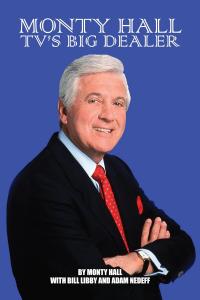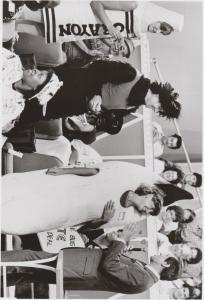
Publisher BearManor Media Celebrates the 60th Anniversary of "Let's Make a Deal"
"Monty Hall - TV's Big Dealer," author Adam Nedeff's expansion of Hall's original autobiography, celebrates 60 years of "Let's Make a Deal" with promo code
Originally released last year, "Monty Hall—TV’s Big Dealer" is a comprehensive biography of the legendary television performer, spanning his childhood in a destitute Jewish family in Winnipeg, Manitoba, Canada; graduating from high school at age 14 and receiving a college education with help from a benefactor; his early work as a sportscaster and reporter; his move to the USA; and the series of events that led to him developing a game show format that would make him famous: "Let’s Make a Deal."
On "Let’s Make a Deal," Hall—billed as “America’s top trader, TV’s big dealer”—would approach members of the audience, many of whom came dressed in Halloween costumes, regardless of the time of year, and offer them a series of deals. $500 or the contents of the box that announcer Jay Stewart was carrying, for example. Whatever the contestant ended up with, Hall might offering them a chance to trade that for what was behind the curtain where the lovely Carol Merrill was standing.
The costumes are an element of the show that still endures on the current incarnation of "Let’s Make a Deal," airing weekdays on CBS with Wayne Brady. But they came about quite by accident. In the early days of the show, audience members wore suits and nice dresses. Since Monty Hall selected contestants from the audience, one enterprising woman, hoping to get his attention, wore a sign around her neck with the inscription, “Roses are red, violets are blue, I came here to deal with you!”
Hall was so delighted that he picked her. A number of viewers followed her lead and showed up at the "Let’s Make a Deal" studio with signs hanging around their necks. This lasted a few months before another audience member showed up wearing an eye-catching hat that prompted Hall to pick her. That led to another series of episodes where audience members showed up with bizarre and ugly hats.
Henry Koval, an assistant to the producers at the time, told co-author Nedeff, “I can still remember the first costume I ever saw. It was a man dressed as the Jolly Green Giant. As I recall, he kept showing up on every taping day and getting tickets at the booth, dressed as the Jolly Green Giant. Looking back, I don’t understand why they kept letting him in. It had reached that point where the audience had signs hanging around their necks and wearing funny hats, but a guy wearing the Jolly Green Giant was still pretty different from what everyone else was doing.
“We finally put him on the trading floor one day. As I recall, the thinking was that we were putting him down there to get rid of him. ‘Give him what he wants and let him be there with Monty and then he’ll go away.’
“Well, Monty was so intrigued by him that he made a deal with the guy. And then that episode aired, and at the next taping, everybody showed up wearing a costume.”
There was no going back after that, and the costumed audience became an unexpected signature for "Let’s Make a Deal."
Though enormously successful—Monty Hall’s creation premiered in December of 1963, and he would host "Let’s Make a Deal" on-and-off for a total of 16 years—the show’s popularity overwhelmed him. Hall had hoped to be known as a jack-of-all-trades performer, a singer/dancer/actor/host and any other type of show business he could think of. But he found himself typecast as “TV game show host Monty Hall,” a role that he had somewhat mixed feelings about.
Robert Hall, Monty Hall’s brother, explains in the book, “I don’t want people to think that Monty hated 'Let’s Make a Deal.' That’s not true at all. He loved that show. He just didn’t love it to a level that he was willing to let it be the only thing anybody knew him for.”
Hall very likely would have preferred to be remembered for his philanthropic efforts. Criss-crossing the country tirelessly to host telethons and fundraisers for decades, Hall raised over $1 billion for assorted charities during his lifetime, devoting a considerable portion of this effort to Variety Club, the children's charity.
The book, a revised and expanded version of Hall’s original 1973 memoir co-written with Bill Libby, includes new research by author Adam Nedeff, who also conducted new interviews with models Carol Merrill and Karen LaPierre, announcers Brian Cummings and Dean Goss, "The People's Court" creator Stu Billett, producer Ron Greenberg ("The Who, What, or Where Game"), and fellow master of ceremonies Tom Kennedy ("Split Second," "Name That Tune"). These were the final interviews granted by Billett and Kennedy. Author Nedeff also devotes an entire chapter of the revised book to explaining, hopefully once and for all, the “Monty Hall Problem,” a confusing probability conundrum that has spurred arguments even among the most expert mathematicians.
BearManor Media, a publisher specializing in books about vintage show business history, is offering the book in hardcover and paperback on its website, www.bearmanormedia.com, and buyers who use the promo code BIGDEAL at checkout can get 30% off their purchase through the end of December.
Co-author Adam Nedeff is a West Virginia native who specializes in game shows. His other titles include:
-"Gong This Book"
-"Game Shows FAQ"
"It’s More Than Password—The Life (and Wife) of Allen Ludden"
"This Day in Game Show History"
"The Matchless Gene Rayburn"
"Okay? Okay!—Dennis James’ Lifetime of Firsts"
"Quizmaster—The Life and Times and Fun and Games of Bill Cullen"
Nedeff also lends his expertise as an archivist and researcher for the National Archives of Game Show History, a wing of the Strong National Museum of Play in Rochester, New York. He’s also been a trivia question researcher for more than a dozen TV game shows.
Adam Nedeff
BearManor Media
email us here
Visit us on social media:
Facebook
LinkedIn
EIN Presswire does not exercise editorial control over third-party content provided, uploaded, published, or distributed by users of EIN Presswire. We are a distributor, not a publisher, of 3rd party content. Such content may contain the views, opinions, statements, offers, and other material of the respective users, suppliers, participants, or authors.




